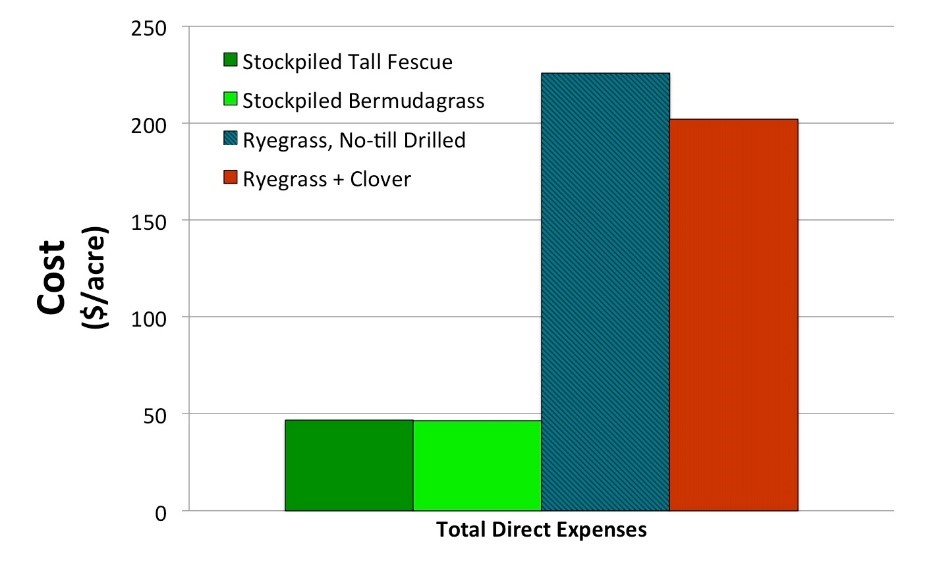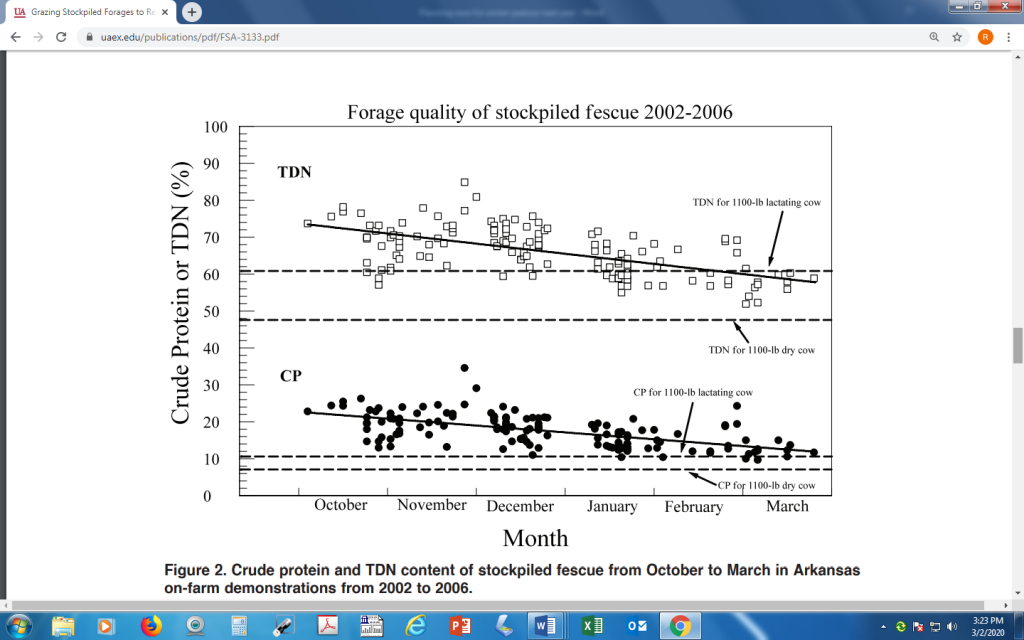Calving percentage is widely recognized as the variable having the greatest impact on profitability of a cow-calf operation. Because expenditures for feed are so large, minimizing those costs is perhaps the next most important strategy to enhance profitability. Expenditures for hay or baleage and supplements usually represent the largest portion of the total feed budget. Most of those expenses are for winter feed.
Producers in South Georgia, where pastures are predominantly warm-season perennials like bermudagrass and bahiagrass are able to use overseeded winter annuals, either small grains or annual ryegrass to “double-crop” and produce grazable forage that complements the summer production from warm-season grasses.
North Georgia producers who depend primarily on tall fescue for pasture production face less obvious alternatives to extend the grazing season during the winter. Overseeding tall fescue pastures with winter annuals is not an uncommon practice in north Georgia. The expectation is that the winter annual will provide more fall and winter grazing than will the tall fescue, which should lengthen the grazing season. Overseeding tall fescue does not have the complementarity that the practice provides with warm-season grasses. Conditions for optimum, rapid growth are very similar for tall fescue, small grains and annual ryegrass. This leads to direct competition for water, nutrients and even sunlight when temperatures for growth are best.
An alternative practice to extend the duration of the grazing season is planned stockpiling of tall fescue. Stockpiling eliminates the cost of seeding and capitalizes on the ability of tall fescue to produce high quality forage that can be grazed in late fall, early winter and even later if pasture growth is carefully allocated.
University of Tennessee forage scientists have compared the yields resulting from overseeding tall fescue with winter annuals to stockpiling tall fescue. Wheat or annual ryegrass was drilled into in mid-September. Each seeding treatment received 0, 60 or 90 lb N/acre. Plots were harvested in the fall and twice in the spring. The first spring harvest was completed considerably earlier than normal hay harvest. This early harvest was done to evaluate the early spring growth of the treatments, which would indicate which were best for providing early season growth to decrease the late winter hay needs. Results indicated that overseeding did not improve fall yield. Fall yield was influenced by N rate, not overseeding species.
Yields were relatively low, but the highest yields were obtained with the higher N rates. Fall N application influenced spring harvest. Data indicated that the overseeding did not improve yield, but fall N did. Applying N in the fall allows tall fescue to produce more forage as well as store more carbohydrates in the roots and crown. This extra carbohydrate storage provides more energy for the plant to begin to grow in spring. Best fall and early spring yield can be obtained through fall fertilization of tall fescue rather than seeding winter annuals into the tall fescue.
Costs required to overseed small grains or annual ryegrass and considerably greater than stockpiling.

Winter annual forages are recognized for the very high nutritional value they can provide when grazed or properly harvested for hay. Research at the University of Arkansas, conducted over 4 years indicates that stockpiled tall fescue can provide very nutritious forage that exceeds both the energy (TDN, total digestible nutrients) and protein requirements for even a lactating beef cow.

Stockpiling has also reduced the toxicity of endophyte-infected tall fescue. One study found that toxin levels in infected fescue decreased during the winter grazing period.
Small grain or annual ryegrass seed is widely available and can be purchased and overseed on short notice in the fall. Greater anticipation and planning is necessary to utilize the superior strategy of stockpiling tall fescue.
Consider the following steps to plan and implement successful stockpiling:
- Plan which areas will be stockpiled and which will be available for fall grazing while stockpiled growth accumulates. A knowledge of pasture carrying capacity and anticipated grazing demand will facilitate planning.
- Use weather records to determine the most probable end of the fall growing season. Allow at least 60 days for tall fescue to accumulate stockpiled growth before the end of the season. Ninety days of growth will result in a greater reserve of stockpiled forage.
- Graze or clip pasture(s) or hayfield to be stockpiled to 3-5 “ height.
- Apply nitrogen fertilizer. Lower rates will provide the greatest response per unit of nitrogen, but research has found a positive yield response to rates as high as 80 lb/acre. 3. Defer grazing stockpiled tall fescue forage until late fall or winter. Be sure to properly use forage growth in other pastures before beginning to use stockpiled forage. However, late- season growth of warm-season species may be of low quality and thus may require supplementation.
- As area allows, plan on 1 acre per cow – this should provide grazing for about 75 or more days.
- Stockpiled forage will provide nutritious feed and should be allocated to animals with higher demand (e.g. lactating cows, growing bred heifers). For spring calving herds, planning to graze lower quality forage like warm-season grass aftermath of crop residues will preserve the stockpiled forage for use following calving. Although tall fescue resists weathering better than some forages, forage quality will decline through the spring. Stockpiled forage should be grazed before adequate spring pasture growth becomes available.
- Plan to allocate stockpiled forage efficiently. Measure the quantity available and use electric fence to provide amounts of pasture area that will be thoroughly grazed in a short period. Careful grazers will allocate and move electric fence daily. Since regrowth will be very limited, there may not be any need for a back-fence to prevent grazing of regrowth.
More information is available in UGA Extension Circular 920 “Stockpiling Tall Fescue for Fall and Winter Grazing” https://extension.uga.edu/publications/detail.html?number=C920&title=Stockpiling%20Tall%20Fescue%20for%20Fall%20and%20Winter%20Grazing